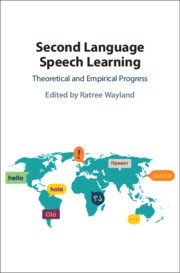Book contents
- Second Language Speech Learning
- Second Language Speech Learning
- Copyright page
- Dedication
- Contents
- Figures
- Tables
- Contributors
- Preface
- Acknowledgments
- Part I Theoretical Progress
- Part II Segmental Acquisition
- Part III Acquiring Suprasegmental Features
- Part IV Accentedness and Acoustic Features
- Part V Cognitive and Psychological Variables
- Chapter 16 Self-Reported Effort of Listening to Nonnative Accented English Depends on Talker Pausing and Listener Working Memory Capacity
- Chapter 17 Investigating the Role of Cognitive Abilities in Phonetic Learning of Foreign Consonants and Lexical Tones
- Chapter 18 Auditory Priming Effects on the Pronunciation of Second Language Speech Sounds
- Chapter 19 Indexical Effects in Cross-Language Speech Perception
- Chapter 20 The Role of Orienting Attention during Perceptual Training in Learning Nonnative Tones and Consonants
- Index
- References
Chapter 19 - Indexical Effects in Cross-Language Speech Perception
The Case of Japanese Listeners and English Fricatives
from Part V - Cognitive and Psychological Variables
Published online by Cambridge University Press: 21 January 2021
- Second Language Speech Learning
- Second Language Speech Learning
- Copyright page
- Dedication
- Contents
- Figures
- Tables
- Contributors
- Preface
- Acknowledgments
- Part I Theoretical Progress
- Part II Segmental Acquisition
- Part III Acquiring Suprasegmental Features
- Part IV Accentedness and Acoustic Features
- Part V Cognitive and Psychological Variables
- Chapter 16 Self-Reported Effort of Listening to Nonnative Accented English Depends on Talker Pausing and Listener Working Memory Capacity
- Chapter 17 Investigating the Role of Cognitive Abilities in Phonetic Learning of Foreign Consonants and Lexical Tones
- Chapter 18 Auditory Priming Effects on the Pronunciation of Second Language Speech Sounds
- Chapter 19 Indexical Effects in Cross-Language Speech Perception
- Chapter 20 The Role of Orienting Attention during Perceptual Training in Learning Nonnative Tones and Consonants
- Index
- References
Summary
In this paper, we explore whether perceptual adjustments for gender are equally strong for Japanese- and English-speaking listeners' categorization of the sibilant fricatives /s/ and /ʃ/ in CV sequences. These stimuli were created by combining a set of eight fricatives with a set of natural vocalic bases produced by a variety of men. We hypothesized that Japanese listeners' categorization would be more-strongly influenced by gender typicality, given the overall heightened attention to gendered speech features in Japanese speakers (Van Bezooijen, 1995), and the greater role that vocalic features play in fricative categorization in Japanese compared to English (Li, Edwards, & Beckman, 2009; Li, Munson, Yoneyama, Edwards, & Hall, 2011). Some evidence is found that Japanese listeners' categorization of fricatives is influenced more heavily on the gender typicality of men's voices in the vocalic portion of the stimulus than is English listeners, but the effects are neither consistent, nor in the direction predicted by previous research. Results point to the need for more research on how talker attributes affect the way that L2 listeners perceive L1 speech.
- Type
- Chapter
- Information
- Second Language Speech LearningTheoretical and Empirical Progress, pp. 463 - 484Publisher: Cambridge University PressPrint publication year: 2021



